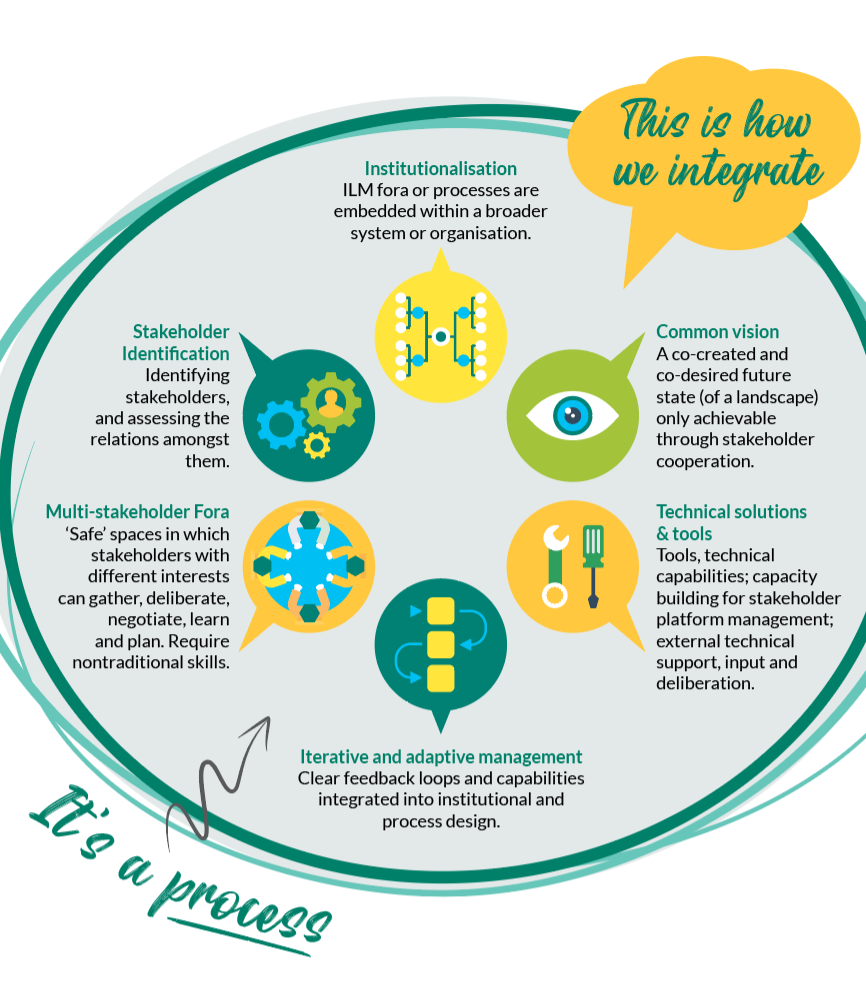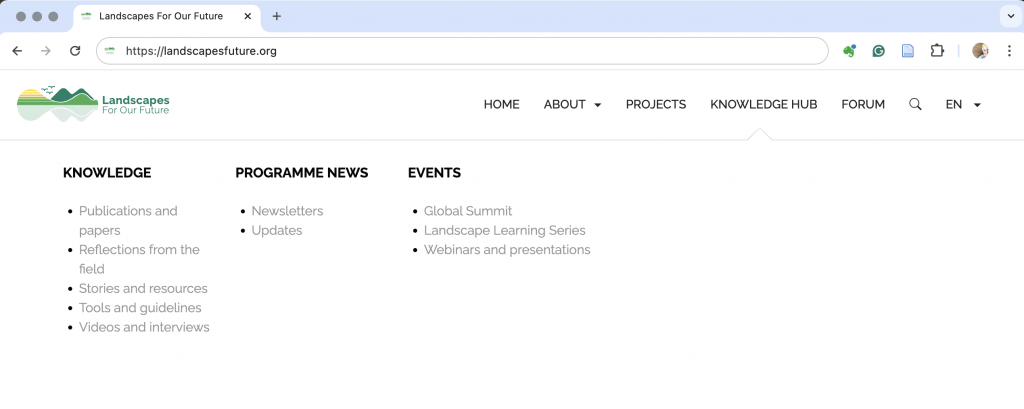
What is Integrated Landscape Management?
We define ILM as
a process for fostering co-created sustainability and resilience in landscapes through adaptive, inclusive and integrating strategies.”
In thinking about ILM as a process we have focused on what this might look like, while recognizing that a wide diversity of variables will influence landscapes and affect their condition.
Read on to find out more or download the full Landscapes in Practice guide here.
Why do we need ILM?
Because disintegration in Natural Resources Management (NRM) is a major problem, and many of the worst environmental problems that we confront today can be traced back to disintegration. It has, for example, been argued that the disintegration amongst the 17 Sustainable Development Goals is a key reason for lack of progress, while the modest success of institutional responses to climate change are another example.
Historically, much NRM has been highly sectoral (‘siloed’) – structured around technical specialities and foci. Governments are a good example of this. Here, responsibility for addressing different parts of different ecosystems (soils, water, air, forests, climate, land, etc.) is distributed across ministries or even across departments within ministries – even if all of these elements within an ecosystem are tightly interconnected. This means that when we do something in one part of a landscape, the interconnections deliver impacts to other parts of the landscape which we may not have considered. For example, industrialization may seem like a positive intervention if we focus on economic growth and development. Still, it will have ‘knock-on’ impacts on air quality, water quality, contribute to climate change, etc. These knock-on impacts are often called ‘unintended consequences’ and are often severe.
The challenge of disintegration is not restricted only to sectors but also to scales. Landscapes are located within a continuum that arguably starts at the most local of scales – such as the microbial processes that influence soil formation, through to the widest, global scales where international decisions are made.
Integrated Natural Resources Management, Integrated Landscape Management, Integrated Water Resources Management and the Water-Food-Energy Nexus are all NRM approaches that have emerged due to the widespread recognition that disintegration is a problem. In many respects, however, it is not the natural resources that are the issue here – but the diffuse or fragmented institutional approaches we deploy to address them.
In our view, therefore, the spotlight of our attention needs to be shifted to designing institutions that are fit-for-the-purpose of addressing highly interconnected natural resources problems.
– Dr Kim Geheb, Central Component Coordinator
What is our approach to ILM?

We have developed a typology of six ILM ‘dimensions’ as an initial hypothesis about ILM, subject to change as learning progressed together with the programme’s projects.
Here’s why these variables were included:
Stakeholder identification

A landscape’s stakeholders are the single greatest determinant of its behaviour as a system. Knowing and understanding who the stakeholders are and the relations between them is a strategic necessity for effective ILM interventions. Stakeholder assessments should be able to provide this information, and to help an intervention to narrow down which stakeholders should populate MSFs.
Not all stakeholders are located in the landscape – there will be others elsewhere at, for example, regional, national, or international levels. In identifying stakeholders, it is important to assume that there will be tensions between them. This will yield information relevant to intervention strategies, and how MSFs may need to be structured – for example, several MSF may be needed if the groups that they address are not on speaking terms, and ways of integrating their combined decisions and knowledge will need to be designed.
Find out more or download our Landscapes in Practice paper on this subject.
Multi-stakeholder fora (MSFs)

MSFs are probably the single most powerful way of enabling integration in the management of any natural resource. MSFs are carefully moderated spaces for stakeholder deliberation and decision-making around a vision. MSFs have significant additional benefits revolving around fairness, inclusion, empowerment, equality and equitability. They also represent a centre into which new knowledge can be developed, introduced and deliberated. The successful coordination of MSFs requires high levels of adaptivity (see below) and ‘soft skills’ (for example, facilitation, mediation, negotiation and convening).
To be effective, MSFs must have purpose – a reason for existing – and one way of providing this is to ensure that they have decision-making powers. This might mean having government stakeholders included – although we do not see this as a prerequisite. An MSF’s decisions might be followed through by local institutions, or through decisions to pursue certain activities. While all MSFs can make decisions at some level, relevant decisions are those that can affect the landscape system’s behaviour.
How MSFs are created and run, and the purposes they fulfil depend on the needs of the intervention and the context within which it is being implemented. Having several MSFs can be positive, given the merits of having many different teams making sense of problems, system dynamics, processing new knowledge and co-creating strategies.
Common vision

For us, a vision is an ideal future state. The purpose of this vision is to enable the formation of a compelling and inspiring place to act from. A vision ideally describes what future relations between stakeholders will look like; and should also consider where the MSF is located in this arrangement. If adversarial stakeholders are able to agree on a common vision, the intervention will have made considerable strides. The vision will almost certainly change during the course of implementation, and participants will be challenged to revisit and reimagine their vision.
Institutionalization

‘Institutionalization’ refers to whether or not a project’s processes are incorporated in a landscape’s governance institutions. Where this happens, the likelihood of project sustainability is significantly increased.
It should be noted that ‘governance’ is not the monopoly of government. Effective governance usually refers to the processes and practices of oversight, decision making and moderation of relationships between authority (formal and customary) and constituents that produces desired outcomes (i.e. well-being or stability). Hence, the adoption of project processes into local social institutions is very important.
Social institutions are “enduring regularities of human action in situations structured by rules, norms, and shared strategies.” In this sense, they are patterns of human behaviour within the social-ecological system, as well as being systems in and of themselves. If new ways of doing things are institutionalized, this can indicate new system behaviours.
Find out more or download our Landscapes in Practice paper on this subject.
Iterative and adaptive management

In complex systems, levels of predictability and guarantee are low. Generally speaking, high levels of project rigidity and inflexibility reduce our ability to navigate complexity, which in turn, limits the ability for change to emerge. As a consequence, we must navigate such systems adaptively.
‘Adaptive management’ refers to:
- The extent to which actions are reversible: here, the idea is to try something new and if this is found not to work, an ability to reverse course is necessary.
- Whether the system can be understood by small space and small time-scale experimentation: the action of ‘trying something new’ is an experiment. Every such action, whether it succeeds or fails, tells us something about the complex system in which we operate, which in turn contributes to our learning. Such ‘experiments’ should be small and of relatively short duration – in part because we do not want to waste resources; but also to try and ensure that our experiments do not yield unintended consequences.
- Whether the rate of learning about the system is rapid enough to provide useful information about subsequent decisions: what is learned about the system needs to be incorporated into implementation. Typically, this yields cyclical implementation profiles, in which regular review of intervention progress, successes and failures results in course adjustments.
Implementing in this way, an intervention progressively improves its ability to generate outcomes (behavioural changes) during the course of implementation – in response to failure and success, as well as the experience of engaging with the system of which it is a part. Once a project has established a vision, it will necessarily have to design the strategies that it will employ for achieving it. Once it detects that a strategy is veering the project away from the vision, the project needs to pause and reconsider: either the vision is unobtainable and needs to change; or another strategy needs to be employed.
Find out more or download our Landscapes in Practice paper on this subject.
Technical solutions and tools

There are a wide variety of tools that can be brought to bear in landscape management, from those addressing the state of the resource base, others to assess whether or not an intervention is having an impact, or those that can be used as useful methods and ways to enable cooperation amongst stakeholders. It is important to note, however, that tools are a means to an end – and not an end in themselves.
Tools and associated approaches can play an important knowledge gathering and sharing role, supporting MSFs with new (technical) knowledge to monitor system changes, and the likely causes and future consequence of trends. These inputs are a complement to other forms of knowledge, in particular, that knowledge gained about system dynamics through an intervention’s networks.
Want to learn more?
- See our Landscapes in Practice series
- Head to our Knowledge Hub at any time for ILM-related knowledge plus news and events from the Landscapes For Our Future programme:




